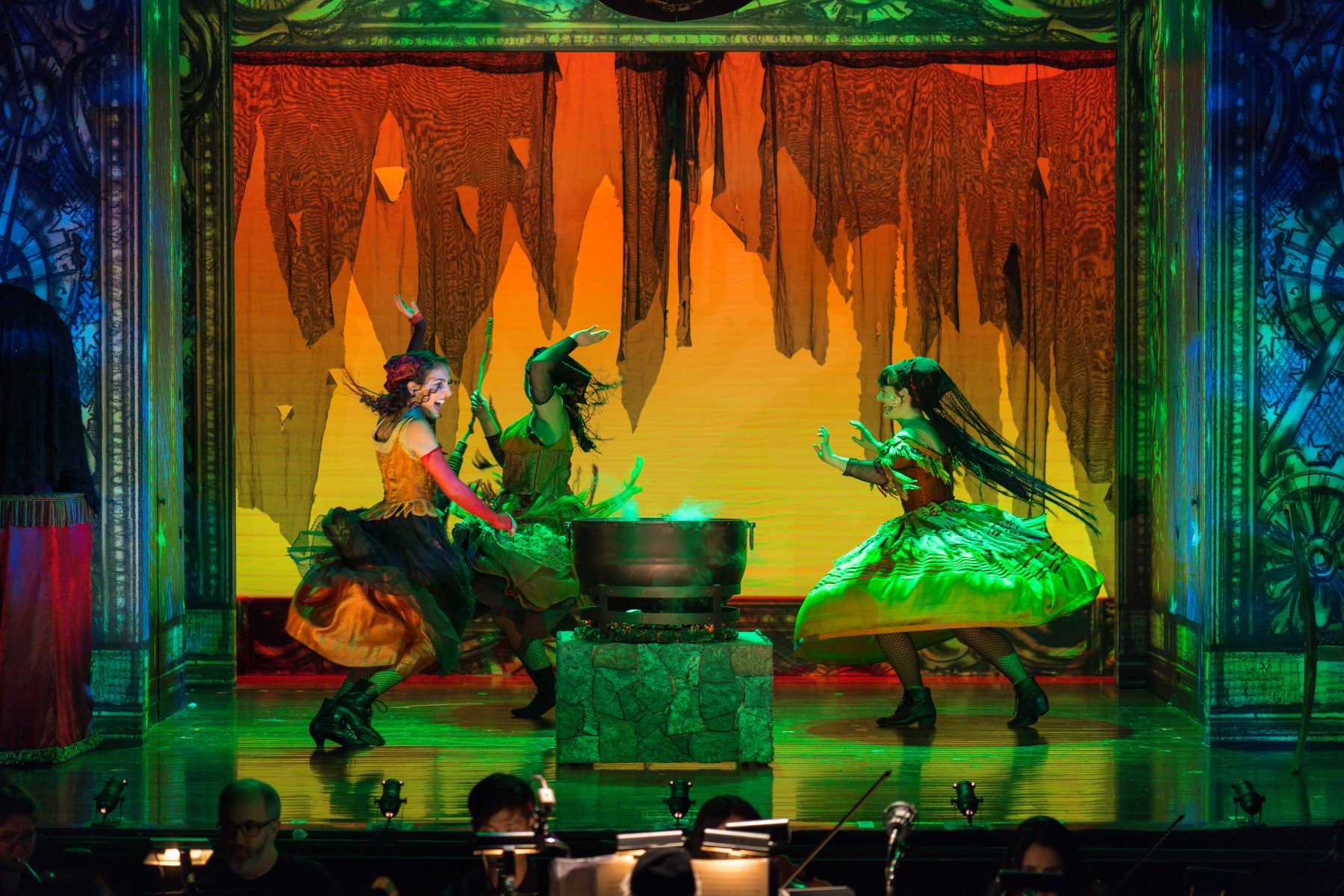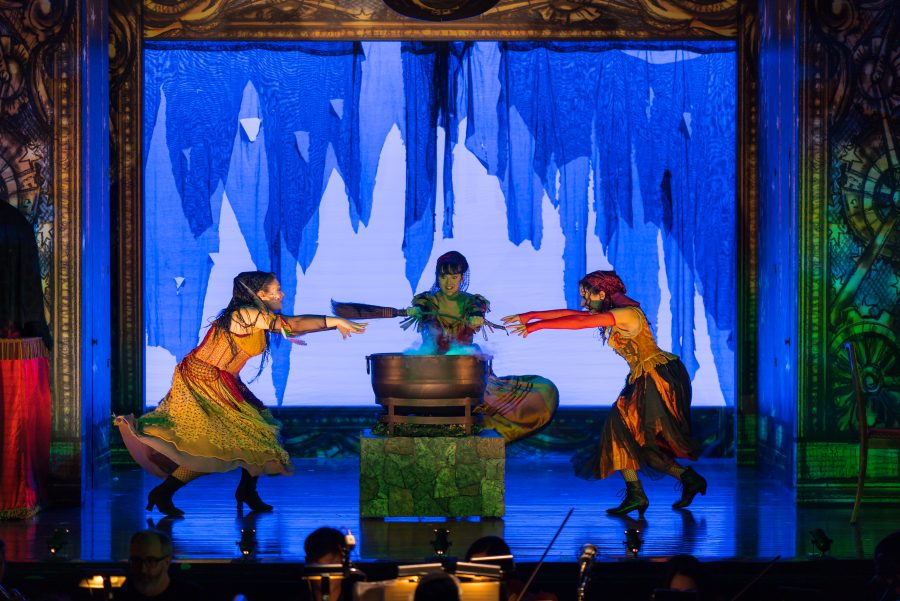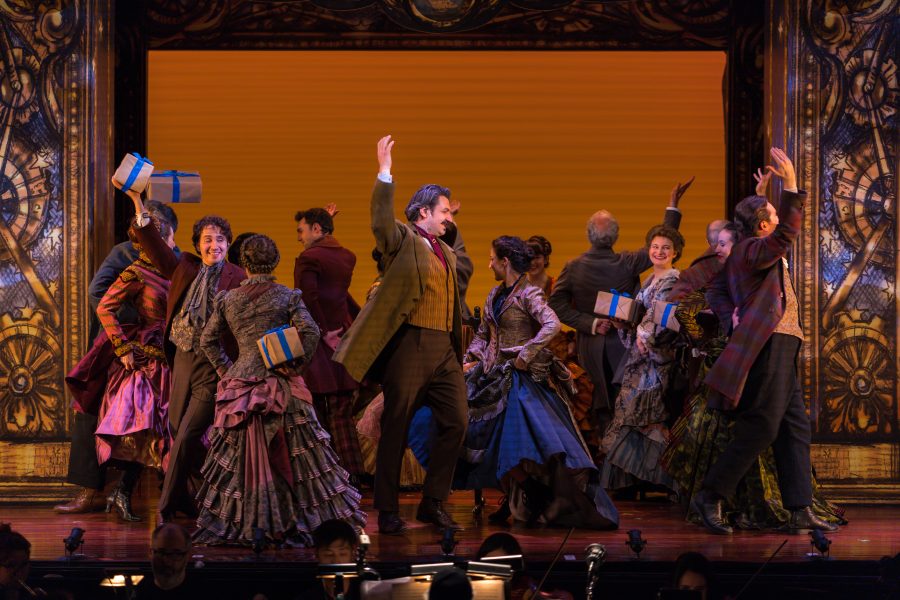
A scene from The Sorceress. From left to right: Lexi Rabadi, Dani Apple, and Lorin Zackular. Photo: ©Victor Nechay - Properpix.com.
Magic and Melody Delight in a Yiddish Fairytale Reborn
Debra Caplan
An evil stepmother. A brave heroine in danger. A handsome fiancé. A conniving sorceress. A plan foiled. A fairytale wedding.
There’s nothing in the plot of the National Yiddish Theatre Folksbiene’s The Sorceress that audiences haven’t seen before—it’s a mashup of Cinderella meets Beauty and the Beast meets The Little Mermaid, a veritable mashup of every Disney movie ever made and the best of nineteenth century melodrama. We may have seen a story like this before, but—at least for most audiences—never in Yiddish, or with Jewish characters, or against the backdrop of shtetl life.

A scene from The Sorceress. From left to right: Dani Apple, Lorin Zackular, and Lexi Rabadi. Photo: ©Victor Nechay - Properpix.com.
The story may be nothing new, but The Sorceress is sheer delight. It’s not just the fact that this fairytale is in Yiddish, or that the costumes are extravagantly perfect, or that Motl Didner’s direction is so exquisite, though all of that is true. In 1877, The Sorceress stunned Jewish audiences with its full-throated theatricality, its high production value, and the scope of author and director Avrom Goldfaden’s vision for a big, bold, evocative Yiddish theatre. One hundred and forty two years later, The Sorceress is still a stunner. Theatre audiences may have grown more sophisticated in the intervening century and a half, but—to a remarkable degree—Goldfaden’s recipe for delighting audiences still works like a charm. It’s hard to imagine any theatregoer—Yiddish-speaking or not—who could leave the The Sorceress without being swept up in its delightful musical fantasia.
The Sorceress is the first fully restored production of the Folksbiene’s new Global Restoration Initiative to identify and present the essential operettas, plays, and musicals of the Yiddish theatre. If this jewel of a show is representative of what we can look forward to from this project, the Folksbiene’s future is very bright indeed.
This production both is—and isn’t—your great-great-grandmother’s Sorceress. The plot and music are more or less the same as The Sorceress that I read in graduate school. But this version has been not only “restored” but also “reconceived” by Zalmen Mlotek, Motl Didner, and Dmitri Zisl Slepovitch.
In addition to reconstructing the score from largely archival materials, and adding additional illustrations when necessary to fill in the gaps, Mlotek, Didner, and Slepovitch also added a prologue and an epilogue to The Sorceress. The prologue is a welcome addition that concisely and clearly introduces the main characters and their relationships to one another and to the sorceress (played with hilarity by a magnetic Mikhl Yashinsky). Like Jacob Gordin’s old adage that he “translated and improved” Shakespeare, Mlotek, Didner, and Slepovitch’s “restored and reconceived” approach to The Sorceress adds new and delightful angles to a beloved classic.
The plot is deceptively simple. In classic melodrama fashion, the world of the play is divided between those who are good and those who are evil. On Team Good: there’s Mirele (played by the effervescent Jazmin Gorsline, a Cinderella-like character who is forced to live with her evil stepmother and stepsister after her father is arrested on false characters; her loving father Avromtsye, and her earnest Prince Charming, Markus (played by Josh Kohane, who brings a captivating vocal performance to the character). On Team Evil, we have Basye, the stereotypical evil stepmother (a wonderfully evil Rachel Botchan), and the eponymous sorceress herself, Bobe Yakhne (in a big, bold performance by Mikhl Yashinsky that is equal parts entertaining and terrifying) who orchestrates a plan to get rid of Mirele for good. And then there’s Hotsmakh, played by Steve Sterner. Hotsmakh is a simple peddler who always seems to wind up in the wrong place at the wrong time. In Sterner’s captivating performance, Hotsmakh often steals the show. He’s The Sorceress’s Everyman, a stand in for all of us ordinary people who aren’t fully good or evil, but something all-too-human and in between. Melodramas do not often include likable characters with flaws. Hotsmakh is the exception to this rule, and in Didner’s capable direction and Sterner’s captivating performance, he reminds us that how far the world of melodrama is from real life.

A scene from The Sorceress featuring the Company. Photo: ©Victor Nechay - Properpix.com.
I won’t spoil the ending except to say that, like all melodramas, it’s a happy one—far happier in Mlotek, Didner, and Slepovitch’s reconception than in Goldfaden’s original Sorceress script, which features one of the more disturbing examples of melodrama’s penchant for punishing villains cruelly, even at the expense of closure for protagonists (the original ending included a joyful song sung by the protagonists as the villains burn to death).
The Sorceress is a classic of the nineteenth century Yiddish stage, and was the first Yiddish show performed in America. Dara Wishingrad’s exquisite nineteenth century picture frame set offers a constant visual reminder of the play’s historical frame and context. The frame is never broken, always subtly reminding us that we’re watching an important part of history.
This operetta may be nearly 150 years old, but it takes up themes that are still relevant today: libelous accusations, false imprisonment, human trafficking, forced servitude, and family separation, amongst others. These themes are underscored by Didner’s direction. The Sorceress offers us a vision of a world where despite all these societal ills, those who are good and moral do truly win in the end, while “those who dig a grave for someone else, fall in it themselves”—a moral that feels both quaint and a necessary reminder in the trying times we live in today. The overall effect is of a play that feels both old and not-so-old at the same time. Any good revival of a classic needs to make an implicit argument for why the play is still relevant. In this, the Folksbiene’s Sorceress succeeds.
On the heels of its wildly successful Fidler afn Dakh / Fiddler on the Roof in Yiddish, the Folksbiene has done it again—another glorious musical production that leaves audiences singing as they exit, whether they know Yiddish or not. “Kim, kim, kim tsi mir,” croons Bobe Yakhne to Mirele. Listen to Bobe Yakhne. This Sorceress is not to be missed.
